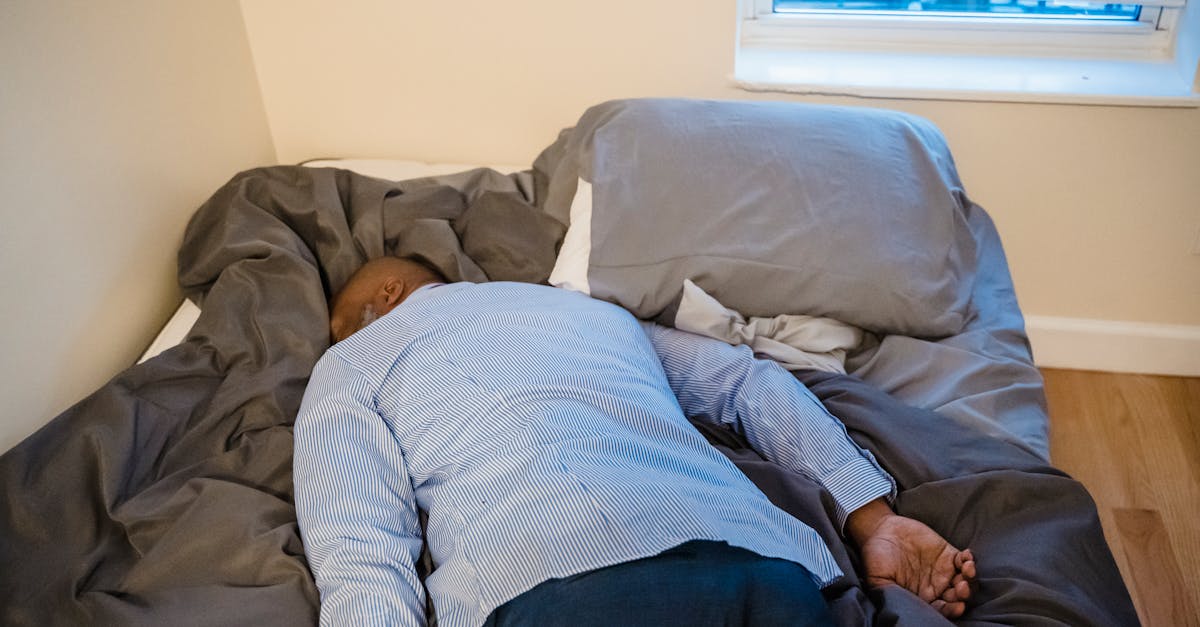|
In Short, relieving neck pain: discover the best sleep positions with Pulse Align is an effective strategy for improving comfort and overall well-being. This approach emphasizes the importance of proper alignment during sleep to alleviate discomfort and enhance recovery. Accessible at Pulse Align Clinics, this method provides tailored solutions that empower individuals to reclaim their freedom of movement. By adopting optimal sleeping postures, clients can experience a drastic reduction in neck tension, improved sleep quality, and a natural return to balance. |
Relieving neck pain can be achieved by discovering the best sleep positions tailored to your needs. Proper alignment during rest is crucial to avoid discomfort such as a stiff neck or pain radiating to the arms. At Pulse Align, our expert recommendations focus on optimal sleeping postures that enhance well-being and foster a natural return to balance. Implementing these strategies can significantly improve sleep quality and contribute to overall health.

Discover the Gentle Wellness of Pulse Align
At Pulse Align, we offer a non-invasive approach that helps restore your body’s natural balance through the power of gentle, imperceptible pulses. This innovative method promotes muscle tone symmetry and supports your body’s innate processes, leading to a remarkable sense of relief from discomfort and tension.
A Focus on Natural Recalibration
Instead of directing efforts towards discomfort or specific conditions, Pulse Align assists the body in recalibrating itself naturally. Our gentle techniques encourage your system to restore its own harmony, which often results in enhanced comfort and improved posture. This holistic approach means that our clients benefit from a journey toward overall wellness, fostering a balanced and resilient body.
Personalized Experiences and Client Testimonials
We pride ourselves on our personalized approach at Pulse Align, which has garnered positive feedback from our clients. Many have shared how they experienced notable improvements in neck and back tension, postural balance, and overall vitality. Their testimonials reflect the effectiveness of our methods, highlighting enhancements in comfort and well-being that have deepened their connection with their own bodies.
Your Journey to Wellness Starts Here
If you are ready to embrace a revitalizing experience, we invite you to explore more about our services. Pulse Align has clinics in various cities, such as Montreal, La Prairie, and Terrebonne. Discover how our safe, non-invasive, and family-friendly approach can benefit both you and your loved ones. We encourage you to book a consultation through our website and begin your journey toward better well-being today!
Note: While Pulse Align complements existing healthcare services, it does not replace medical care. Clients should continue to consult with their healthcare teams for any medical conditions they may have.
- Back Sleeping: Use a small, supportive pillow under the neck for optimal alignment.
- Side Sleeping: Choose a thicker pillow to keep the neck aligned with the spine.
- Fetal Position: Curl knees up and place a pillow between them for added support.
- Stomach Sleeping: Minimize this position; if necessary, use a very thin pillow.
- Elevated Sleeping: Elevate your head slightly to relieve pressure on the neck.
- Pillow Choice: Select a pillow that fits your sleeping style for best results.
- Gentle Stretches: Incorporate gentle stretching before bed to ease tension.
- Good Sleep Hygiene: Maintain a consistent sleep schedule for optimal rest.

Struggling with neck pain? Discover how optimizing your sleep positions can play a pivotal role in alleviating discomfort and enhancing overall well-being. This guide highlights effective strategies for relieving neck pain through proper sleep positions, emphasizing the importance of alignment and comfort for restorative rest. At Pulse Align, we focus on a holistic approach that supports your body’s inherent healing abilities, guiding you toward a more balanced life.
The Role of Sleep in Neck Pain Management
Sleep is essential for physical recovery and mental rejuvenation, yet the way you sleep can either contribute to or alleviate neck pain. Poor sleep positions often lead to increased tension, stiffness, and discomfort upon waking. Understanding the impact of your sleeping habits is crucial for those suffering from chronic neck pain.
At Pulse Align, we recognize the importance of optimal sleep positions and aim to guide you in adopting effective strategies that not only reduce pain but also promote healing. By prioritizing your sleep posture, you can create a nurturing environment for your body to relax and regenerate.
Recommended Sleep Positions for Neck Pain Relief
Back Sleeping
Sleeping on your back can help maintain the natural curvature of your spine. It is advisable to use a small, supportive pillow that adequately supports your neck without lifting your head too high. This positioning prevents unnecessary strain and aligns your head and spine correctly, aiding in neck pain relief.
Side Sleeping
For those who prefer sleeping on their side, choose a thicker pillow that aligns your neck and head with your spine. This height ensures that your neck is not bent unnaturally, reducing the risk of stiffness and discomfort. Additionally, placing a pillow between your knees can help maintain spinal alignment.
The Fetal Position
The fetal position can be beneficial for relieving neck pain, especially when you draw your knees toward your chest with a pillow in support. This position promotes the natural curve of your spine and can provide necessary lateral support to your neck.
Stomach Sleeping
It is generally recommended to minimize stomach sleeping, as this position can strain your neck due to twisting. However, if you find it difficult to avoid, consider using a very thin pillow or none at all to reduce neck strain while you sleep.
Incorporating Gentle Neck Exercises
In addition to optimizing sleep positions, incorporating gentle neck exercises into your daily routine can further enhance your neck’s health. Activities such as light stretching before bedtime can relieve tension built up throughout the day. Combine these exercises with regular posture correction techniques to support your body’s natural alignment.
The Importance of Stress Management
Stress can significantly impact neck pain, exacerbating discomfort and tension. Techniques such as deep breathing, meditation, and relaxation exercises can help manage stress levels, subsequently reducing the tightness in your neck muscles. At Pulse Align, we encourage the integration of these strategies into your lifestyle for optimal health.
Embrace a Holistic Approach with Pulse Align
Taking charge of your neck health involves more than just isolated adjustments. Embracing a holistic approach aligned with Pulse Align principles fosters health, symmetry, and overall neuromuscular recalibration. By exploring effective sleep positions, engaging in gentle exercises, and managing stress, you empower your body to reclaim balance and alleviate neck discomfort.
| Sleep Position | Benefits for Wellness and Balance |
|---|---|
| Back Sleeping | Promotes optimal neck alignment; encourages natural muscle relaxation. |
| Side Sleeping | Facilitates proper spinal alignment, enhancing comfort during rest. |
| Fetal Position | Supports the spine’s natural curve, reducing potential tension in the neck. |
| Stomach Sleeping | Minimizing this position decreases strain on neck muscles. |
| Elevated Sleeping | Helps relieve pressure on the neck, promoting a balanced body position. |
| Pillow Choice | Choosing the right pillow maintains neutral neck positioning, aiding relaxation. |
| Gentle Stretches | Incorporating stretching can ease tension and better prepare for restful sleep. |
| Consistent Sleep Schedule | Maintaining regular sleep patterns enhances overall body balance and recovery. |
| Mindful Sleep Hygiene | Limiting screen time promotes quality rest, contributing to a well-balanced life. |
| Postural Assessment | Regular evaluation of sleep posture encourages natural body recalibration. |

Client Testimonials: Enhancing Wellness through Optimal Sleep Positions
“Since I began my journey with Pulse Align, I have experienced remarkable improvements in my neck pain. The team taught me how to adopt the best sleep positions, which allowed my body to recalibrate and restore its natural balance. Each night, I wake up feeling rejuvenated, ready to embrace my day without the constraints of discomfort. In La Prairie, where wellness is a community focus, I believe that many would benefit from this holistic approach.”
“I had struggled with chronic neck pain for years until I discovered Pulse Align. Their unique method of integrating natural healing and optimal sleep strategies provided me with relief I didn’t think was possible. Every session reinforced my body’s ability to heal itself. Living in Mont-Royal, I feel fortunate to have access to such supportive services that focus on my overall well-being.”
“The positive changes I’ve felt since incorporating Pulse Align’s recommendations into my routine are incredible. Not only have I alleviated my neck pain, but I also feel more connected with my body. This journey has been about learning to listen to what it needs. For anyone in Terrebonne experiencing similar discomfort, I highly recommend this healing path.”
“Pulse Align’s approach to sleep positions has truly saved my well-being. Their dedication to helping clients like me achieve a harmonious balance has made a huge difference in my life. I have friends in Les Escoumins who are also struggling—sharing my experience, they should definitely explore the incredible resources available through Pulse Align. Together, we can reclaim our health.”
“Wanted to share how thrilled I am with my progress! Pulse Align guided me in understanding the importance of proper sleep posture and how minimal adjustments led to major improvements. Living in Châteauguay, I now advocate for this holistic recovery method, as it complements the healthcare I already receive. I feel more aligned than ever!”
“My experience with Pulse Align has been empowering. The team not only addressed my neck pain but also emphasized my body’s ability to self-heal. I appreciate the collaborative approach with my healthcare provider. For those in Sainte-Marie and beyond, I recommend exploring the life-changing effects of their services.”
“Grateful for Pulse Align’s expertise! I learned how to choose the best sleep positions that support my neck, and it’s made all the difference. I want to encourage anyone in Saint-Jérôme or Deux-Montagnes to seek out their supportive treatments. Together with the healthcare community, Pulse Align is making a meaningful impact on wellness journeys.”
If you’re ready to embark on your own wellness journey and discover effective strategies for relief, visit Our Clinics to find a Pulse Align location near you.
Neck pain can hinder daily activities, affecting both physical mobility and emotional well-being. Sleep positions play a crucial role in minimizing discomfort and promoting recovery. With the right techniques, individuals can experience significant relief from neck pain, enhancing overall quality of life. At Pulse Align, a holistic approach to wellness emphasizes the importance of proper sleep alignment to alleviate neck discomfort.
Dr. Sylvain Desforges, an esteemed expert in osteopathy, naturopathy, and manual medicine, is the founding president of TAGMED clinics and the ACMA association. His extensive career has been dedicated to healthcare innovation, integrating traditional practices with advanced technologies to redefine patient care. Specializing in chronic pain management, Dr. Desforges focuses on tailored treatment plans that address the root causes of discomfort while enhancing his patients’ overall health and well-being.
Through his clinic, Dr. Desforges incorporates a range of advanced therapies, including spinal decompression, laser therapy, and shockwave therapy. These techniques aim not just to relieve pain but to promote the healing process, enabling patients to regain their vitality and live without the limitations imposed by discomfort. His mission is clear: to provide evidence-based care that optimizes health outcomes for individuals suffering from various conditions, including neck pain.
The relationship between sleep positions and neck pain is significant. When individuals sleep in improper positions, it can lead to increased pressure on the neck muscles and joints, exacerbating discomfort. At Pulse Align, patients are guided toward adopting optimal sleep postures that support either their back, side, or fetal positions, which can substantially reduce neck pain intensity. Utilizing simple adjustments, such as choosing the right pillow height, can make a remarkable difference in promoting better alignment and alleviating tension.
For instance, back sleepers benefit from a small and supportive pillow that keeps the neck aligned with the spine, minimizing strain while they rest. Side sleepers should opt for thicker pillows to maintain the neck’s alignment in relation to the spine, reducing the likelihood of developing stiffness. Meanwhile, those who prefer the fetal position can enhance comfort by drawing their knees to their chest and placing a pillow between them for added support. It is crucial for patients to understand that specific adjustments to their sleeping habits can lead to meaningful improvements in neck health.
Dr. Desforges advocates for a comprehensive approach to wellness, incorporating not just effective sleep positions but also lifestyle modifications aimed at alleviating neck pain. This includes integrating gentle stretching and strengthening exercises into one’s daily routine. Furthermore, focusing on ergonomic adjustments in workspaces is essential to minimize neck strain from prolonged sitting or poor posture during activities.
Ultimately, addressing neck pain requires a multifaceted approach that encompasses proper sleep positions and holistic treatment modalities. Patients are encouraged to explore the benefits of this comprehensive strategy at Pulse Align, where expert guidance from Dr. Sylvain Desforges and his team can empower individuals on their journey toward enhanced well-being. Understanding the importance of sleep in managing neck pain is the first step toward reclaiming a pain-free lifestyle.
Neurovertebral Decompression Technology by TAGMED
Mécanisme d’action
Neurovertebral decompression technology by TAGMED operates by applying a controlled, progressive traction force to the spine. This mechanistic approach serves to increase the space between vertebrae, thereby reducing pressure on intervertebral discs and nerve roots. Through this process, better fluid circulation in the targeted areas is facilitated, contributing to a decrease in inflammation and pain relief. The gentle pull on the spine enables the discs and nerves to recover, allowing the body to harness its inherent healing capacity.
Avantages spécifiques
This non-invasive method effectively alleviates chronic pain and symptoms linked to conditions such as herniated discs, bulging discs, and spinal stenosis. By reducing pressure on nerve structures and optimizing fluid flow around the discs, TAGMED’s approach supports quicker recovery times and substantial improvements in daily life quality. Patients typically find relief from chronic discomfort, paving the way for enhanced mobility and overall well-being.
Comparaison avec d’autres traitements
When positioned against other common therapeutic strategies such as pain medications, corticosteroid injections, and surgical interventions, TAGMED’s neurovertebral decompression stands out for its efficacy and safety. Unlike invasive procedures that bear risks of complications, this technique is non-invasive, thereby minimizing potential medication-related adverse effects. Furthermore, patients often experience a more expedited path to recovery, avoiding the setbacks associated with more invasive approaches.
Études de cas ou témoignages
Numerous patients have shared their success stories following TAGMED’s neurovertebral decompression treatment. One patient reported, “After undergoing the therapy, my chronic pain significantly diminished, and I can now engage in my daily activities without discomfort.” Another individual noted, “I was able to reduce my dependency on pain medications, as the therapy paved the way for sustainable healing.” These testimonies highlight the tangible benefits that the technology can bring, illustrating a natural pathway to comfort and improved quality of life.
Finding the right sleep positions is crucial for those struggling with neck pain. At Pulse Align, we emphasize the connection between sleep habits and overall well-being. Many individuals experience discomfort that hinders both their ability to rest and their daily activities. By optimizing your sleep posture, you can significantly alleviate these issues, ultimately leading to a more fulfilling and pain-free life.
The strategies we offer are designed to promote healing while respecting your body’s natural alignment. Proper sleep positions can help relieve pressure on sensitive areas of the neck, reducing the risk of stiffness and pain. Whether you prefer to sleep on your back, side, or in a fetal position, understanding how to position yourself can be transformative. For instance, using a supportive pillow that maintains your neck’s natural curve can be pivotal in preventing discomfort.
Additionally, incorporating gentle stretching and maintaining good sleep hygiene can enhance the effectiveness of these strategies. At Pulse Align, we provide clients with tailored recommendations that address their unique circumstances. Our holistic approach combines practical advice and advanced techniques to help you achieve optimal postural alignment during sleep.
Clients have reported remarkable improvements in their quality of life after adopting our recommendations, noting better sleep and reduced discomfort. We believe that reclaiming your health should be simple and accessible—therefore, we are dedicated to guiding you through this essential aspect of wellness. Explore how you can transform your relationship with sleep and discover newfound comfort with Pulse Align.

Do you suffer from a chronic condition that responds little or not at all to conservative treatments?
Welcome to Pulse Align, where we provide a non-invasive, innovative method designed to help restore your body’s natural balance and posture through gentle, imperceptible pulses. This unique approach supports the body’s natural processes, contributing to a greater sense of comfort and improved well-being. By focusing on enhancing muscle and joint alignment, Pulse Align allows you to experience a holistic approach to managing discomfort, fostering a refreshing alternative to conventional methods.
At Pulse Align, we don’t target discomfort or conditions directly; instead, our focus is on helping your body recalibrate naturally. Clients often experience remarkable improvements in their overall comfort and balance, as our techniques promote symmetry in muscle tone and posture without the need for invasive methods. This gentle recalibration process may enhance your daily experiences, encouraging you to embrace life with renewed vitality.
Our commitment to personalized care is at the heart of what we do. Many clients have shared their inspiring stories of transformation, noting significant improvements in neck and back tension, along with a sense of overall wellness. With our approach, individuals of all ages, including children and pregnant women, have found value in the gentle relief and balance that Pulse Align offers. These testimonials highlight the positive impact of focusing on the body’s natural ability to restore itself, reinforcing the idea that a holistic approach can lead to delightful results.
We invite you to discover more about Pulse Align by visiting our website, where you can find nearby locations in La Prairie, Mont-Royal, Terrebonne, and other cities. Here, you can easily book a consultation for yourself or your family. It’s important to note that while Pulse Align complements and enhances the care provided by your healthcare team, it is not intended to replace any medical services. Our approach is safe, non-invasive, and family-friendly, so you can feel confident in the path you choose toward wellness.
To learn more about our services and book an appointment, visit our website: Pulse Align.
Frequently Asked Questions
Neck Pain
Does working on a computer cause neck pain?
Often, yes. A forward head position in front of a screen can strain the cervical region.
Do breathing exercises help?
Proper breathing reduces stress and muscle tension, helping alleviate neck pain.
Can massage balls help relax neck muscles?
Yes, using a tennis or massage ball gently against the neck can relieve muscle tension.
Does holding my phone cause neck pain?
Yes, holding a phone with your head tilted down for extended periods can cause neck strain.
Can meditation help?
Meditation reduces stress and muscle tension, indirectly aiding in relieving neck pain.
Is physiotherapy effective?
Yes, a physical therapist can provide exercises, stretches, and manual therapy to relieve cervical pain.
Are cervical manipulations dangerous?
If performed by a qualified professional, they are generally safe, though there is a slight risk of complications.
Are heated cervical collars useful?
Yes, they combine support and warmth, providing temporary relief.
Can I use heating patches?
Yes, heat patches can provide temporary relief by relaxing muscles and improving blood flow.
Is swimming helpful?
Yes, swimming improves posture, strengthens back muscles, and can relieve cervical tension.
Sophie Gambert understands that neck pain is far more than a physical ache—it’s a roadblock to living the life you love. As a Neck Pain Awareness Advocate at Pulse Align, she is committed to shedding light on the underlying causes, sharing practical relief strategies, and offering genuine support to readers seeking to reclaim their freedom of movement. With a warm, empathetic voice and a keen eye for the latest in pain management research, Sophie leads conversations that uplift, educate, and inspire. She believes that every individual deserves to feel heard, understood, and guided toward healing, one step at a time.
Medical Disclaimer
The information and advice provided on this site do not replace the advice, diagnosis, or treatment of a healthcare professional. Please note that the author of this article is neither a doctor nor a specialist in a medical specialty as defined by the Collège des médecins du Québec. Manual medicine, functional medicine, and sports medicine as described on this site exclude any medical treatment or diagnosis made by a doctor or medical specialist. Always consult your doctor for any medical questions. For more details, please read our complete Legal Notice.




